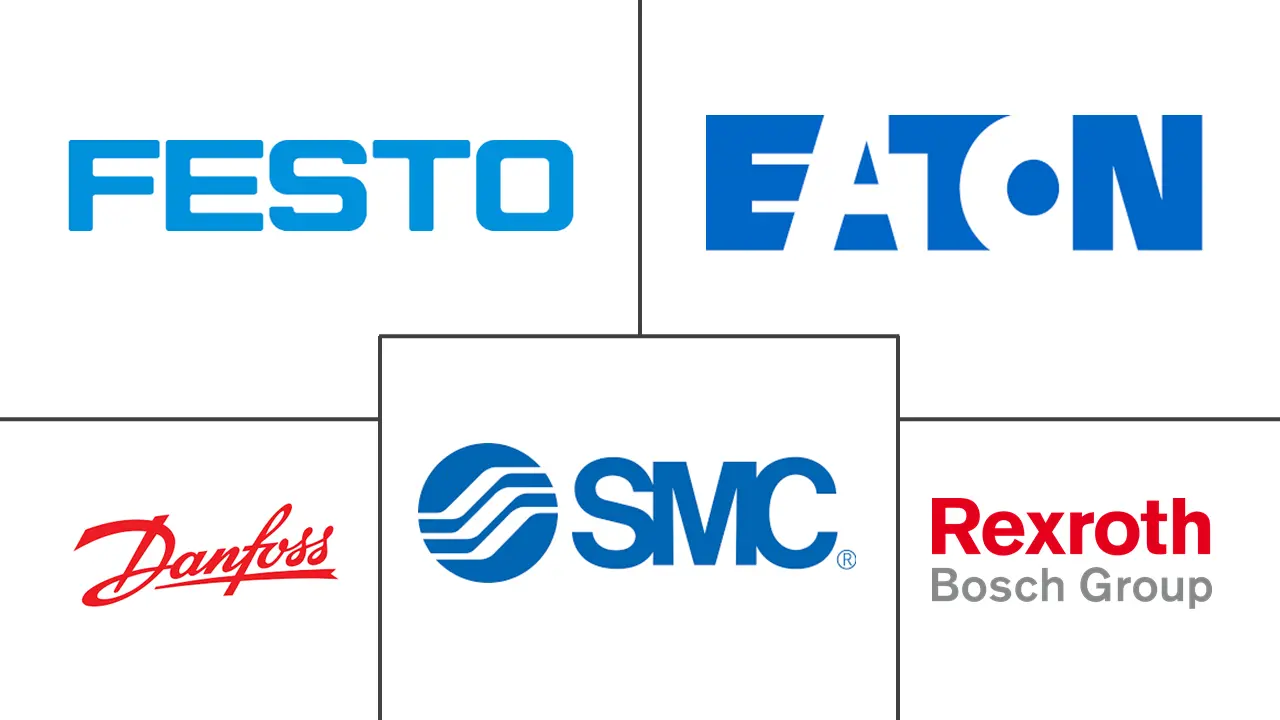Market Size of Fluid Power Equipment Industry

| Study Period | 2019 - 2029 |
| Base Year For Estimation | 2023 |
| CAGR | 6.20 % |
| Fastest Growing Market | North America |
| Largest Market | Asia-Pacific |
| Market Concentration | Medium |
Major Players
*Disclaimer: Major Players sorted in no particular order |
Need a report that reflects how COVID-19 has impacted this market and its growth?
Fluid Power Equipment Market Analysis
The Fluid Power Equipment Market size is expected to grow from USD 46.19 billion in 2023 to USD 62.40 billion by 2028, at a CAGR of 6.20% during the forecast period (2023-2028).
The industry is witnessing significant development in the lines of automation as companies move towards a more intelligent environment. Several key stakeholders operating in the market are banking upon creating a synergy between the hydraulic products and the electrical division. Advancements in hydraulic technology in the current market include liquid power transmission, mobile diagnostic tools, simplified hose selection, thermoplastic components, and electrohydraulic control.
- Vendors highly stress the regular maintenance of hydraulic equipment to avoid high repair and replacement costs. Furthermore, maintenance ensures the reduction of downtime for operations as cleaning and checking the equipment can be a matter of minutes, replacement an event of hours, whereas complete repair could suffer productivity by a more extended period.
- For instance, in April 2021, REHOBOT Hydraulics announced the launch of the PME70-2500MRV/VR70, an electric-powered hydraulic pump. This pump is incorporated with a low-maintenance induction motor, and it is designed to meet the needs of many clients in many application industries.
- The wave of Industry 4.0 across the globe is boosting the growth of connected hydraulic equipment with a paradigm shift of focus on smart and intelligent systems. Machine manufacturers, especially in Europe, are digitalizing the machines. The networking is expected to facilitate the advancement of connected systems in the hydraulic equipment for seamless integration with other machines. This can be noted in the trend of moving from analog hydraulic equipment to digitized hydraulic technology.
- The advent of automation in manufacturing processes in several end-user verticals, including Food Processing and Packaging, Automotive, Material Handling and Assembly, and Chemicals/Plastics/Oil, directly impacted the adoption of pneumatic equipment. Further, the evolution of labor-saving devices, automatic machinery, and automatic-control systems directed an increase in the use of pneumatics.
- The trend of adopting pneumatic equipment for various operations is facilitated by the need for high energy efficiency that is offered by this equipment. Furthermore, companies are focusing on providing flexibility in the design of pneumatic equipment. For instance, pneumatic actuators are sized to the application considering the necessary force, pressure, and mechanical limitations through online sizing software and cylinder configuration tools.
- Another trend that has gained traction in the market studied is reduced fluid volumes relative to pump flow rates for smaller and lighter equipment. The lower fluid volume in mobile hydraulic equipment allows less time in the sump. This translates to less time for cooling and the elimination of entrained air.
- The COVID-19 pandemic created significant supply chain disruptions for the manufacturing of hydraulic power equipment. Manufacturers were forced to shut down factories due to the nationwide lockdown, which created a supply and demand cycle gap. The National Fluid Power Association detailed the pandemic's impact on companies, with a few of them being incredibly hit while others being able to show resilience. In addition to economic decline and lockdown challenges, the market studied has seen the rise of customization as a key trend in hydraulic equipment dealing with heavy-load material handling during the COVID-19 pandemic.
